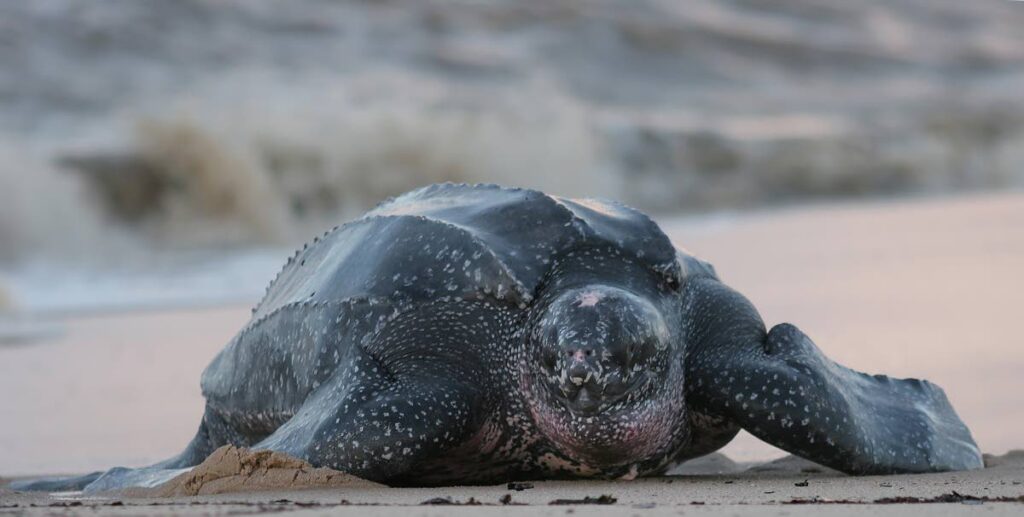EMA: Be cautious during turtle nesting season

The Environmental Management Authority has designated five sea turtle species as Environmentally Sensitive Species (ESS) – the green, hawksbill, leatherback, loggerhead, and the olive ridley species.
From March 1-August 31 these five species nest on Trinidad and Tobago's beaches.
Courageous efforts are continuing by the relevant state agencies, non-governmental organisations and even individual beachgoers to protect these ESS and their habitats. However, many challenges persist when protecting these species; therefore, our duty as citizens is to preserve them, the EMA said in a media release.
The EMA listed the following as protected nesting sites:
Prohibited areas
Grande Rivière
Matura
Fishing Pond
Other nesting sites of importance
Las Cuevas
Blanchisseuse
Yarra
Sena
Cocos Matelot
Paria
Chacachacare
Toco (Red Sand, Salybia, Patience)
Tobago nesting sites
Stonehaven Beach (Grafton)
Hermitage
Cotton Bay
Richmond
Dead Bay
Mt Irvine
Little Rockly Bay
Englishman’s Bay
Bloody Bay
Courland
For the further protection of these species, Matura beach, Fishing Pond beach and Grande Rivière beach have been identified as Prohibited Areas under the Forests (Prohibited Areas) Order of the Forests Act, Chapter 66:01 and special permission from the Forestry Division of the Ministry of Agriculture, Land and Fisheries is required to access the beaches for turtle viewing, the EMA said.
During the turtle nesting season, individuals are asked to act responsibly and take necessary precautions to further preserve the lives and habitats of the turtles.
Safety precautions
Here are some general safety tips/precautions (sourced from the National Sea Turtle Task Force [NSTTF]) to observe during turtle nesting season/when visiting turtle nesting sites:
• The three main nesting beaches of Grande Riviere, Matura and Fishing Pond are prohibited areas; permission is required by law for turtle viewing at these sites. Ensure you have a permit and/or trained guide with you at all times. For other beaches/nesting sites, the use of guides for a safe, educational, and rewarding experience is recommended.
• Do not drive on nesting beaches.
• Keep a safe distance, up to 20 metres, from the laying turtle.
• Wear comfortable shoes and long dark-coloured clothing – some beaches are long and there may be a walk to a nesting turtle.
• Do not leave trash on the beach.
• Do not use stakes or bury items in the sand or dig.
• Remove beach furniture (eg, umbrellas, tents, and chairs).
• Do not pick up hatchlings or hinder their progress to the sea unless advised by a certified turtle tour guide.
• There should be no touching, or very minimal since sea turtles can carry known, harmful bacteria (salmonella) and viruses (herpes) that can infect people.
The release said these species are protected by law and appropriate enforcement action will be taken against those committing acts in contravention of the Legal Notices designating the turtles as ESS (the notices can be accessed via the following link:
https://www.ema.co.tt/ema-legal/legislation/).
Environment offence
The Environmental Management Act, Chapter 35:05 states: "Any person who knowingly or recklessly undertakes or conspires to allow any activity in an ‘environmentally sensitive area’ or with respect to an ‘environmentally sensitive species’ designated under Section 41, which may have an adverse impact on the environment within such area or on such species, commits an offence..."
Anyone who commits an offence involving any of the ESS, including the five turtles, can be imprisoned for two years and pay a fine of $100,000.
To report any breaches contact the EMA’s Hotline at 367-8824 (submit contact information, locations, photos or video recordings ONLY from mobile devices. WhatsApp calls are not available on this service) or complaints@ema.co.tt or 226-4EMA (4362) Ext #5.

Comments
"EMA: Be cautious during turtle nesting season"